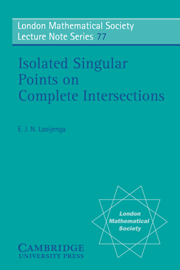Book contents
- Frontmatter
- Contents
- INTRODUCTION
- CHAPTER 1 EXAMPLES OF ISOLATED SINGULAR POINTS
- CHAPTER 2 THE MILNOR FIBRATION
- CHAPTER 3 PICARD-LEFSCHETZ FORMULAS
- CHAPTER 4 CRITICAL SPACE AND DISCRIMINANT SPACE
- CHAPTER 5 RELATIVE MONODROMY
- CHAPTER 6 DEFORMATIONS
- CHAPTER 7 VANISHING LATTICES, MONODROMY GROUPS AND ADJACENCY
- CHAPTER 8 THE LOCAL GAUSS-MAN IN CONNECTION
- CHAPTER 9 APPLICATIONS OF THE LOCAL GAUSS-MANIN CONNECTION
- REFERENCES
- INDEX OF NOTATIONS
- SUBJECT INDEX
CHAPTER 5 - RELATIVE MONODROMY
Published online by Cambridge University Press: 17 March 2010
- Frontmatter
- Contents
- INTRODUCTION
- CHAPTER 1 EXAMPLES OF ISOLATED SINGULAR POINTS
- CHAPTER 2 THE MILNOR FIBRATION
- CHAPTER 3 PICARD-LEFSCHETZ FORMULAS
- CHAPTER 4 CRITICAL SPACE AND DISCRIMINANT SPACE
- CHAPTER 5 RELATIVE MONODROMY
- CHAPTER 6 DEFORMATIONS
- CHAPTER 7 VANISHING LATTICES, MONODROMY GROUPS AND ADJACENCY
- CHAPTER 8 THE LOCAL GAUSS-MAN IN CONNECTION
- CHAPTER 9 APPLICATIONS OF THE LOCAL GAUSS-MANIN CONNECTION
- REFERENCES
- INDEX OF NOTATIONS
- SUBJECT INDEX
Summary
The term relative monodromy refers to a powerful method by means of which many homotopy properties of Milnor fibres and Milnor fibrations can be proved inductively. As far as the author knows this notion was introduced by R. Thom but the most effective use of it was certainly made by D. T. Lē (1973, 1978).
The usual situation is that one is given an analytic germ f = (f1, …, fk) : (X, x) → (Ck, 0) such that both f and f' ≔ (f1, …, fk−1) : (X, x) → (Ck−1, 0) define an isolated singularity. A basic result then asserts that f admits a good representative of the form f : X → S'×Δ (⊂ Ck−1×C) such that its composition with the projection S'×Δ → S' is topologically equivalent to a good representative of f'. This fact is used to prove many homotopy properties of Milnor fibrations inductively: (a) with induction on the fibre dimension n that any fibre has the homotopy type of a finite complex of dim ≤ n, (b) essentially with induction on k that in the complete intersection case any fibre of dim n is (n−1)-connected and finally (c), if k = 1 (with induction on n again) that the homological monodromy of the Milnor fibration is quasi-unipotent of index ≤ n.
The basic construction
(5. 1) Throughout this section X stands for an analytic set in an open ∪ ⊂ CN and x is a point of X such that X−{x} is nonsingular of pure dimension n+k.
- Type
- Chapter
- Information
- Isolated Singular Points on Complete Intersections , pp. 67 - 89Publisher: Cambridge University PressPrint publication year: 1984



